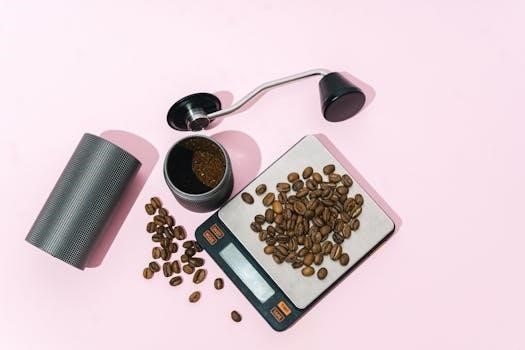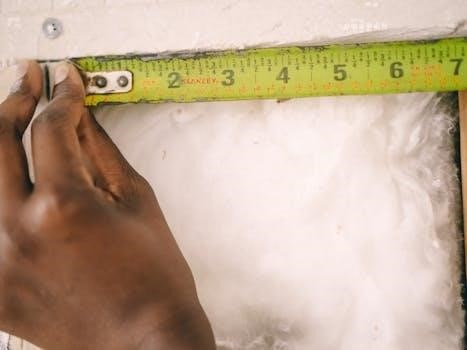
These manuals are your essential guides to understanding and utilizing the full potential of your Weight Watchers scale. By purchasing a WW scale, you are taking a positive step toward managing your wellness journey, and the user manual will help.

Overview of Weight Watchers Scales
Weight Watchers scales, often manufactured by Conair, are designed to assist individuals in their weight management goals. These scales come in various models, each with unique features to cater to different user needs. Many feature step-on activation and auto-off functions to conserve battery life, ensuring they are convenient and user-friendly. Some scales are basic, providing only weight readings, while others offer advanced body analysis capabilities, including measuring body fat percentage, body water percentage, and bone mass using bioelectrical impedance analysis. Certain models also incorporate Bluetooth connectivity, allowing users to sync their data with the WW app and track their progress over time. These scales are intended to provide accurate measurements and are a valuable tool for individuals committed to managing their weight and overall body composition. User manuals are provided to guide users through the setup, operation, and various features of their specific scale model.

Initial Setup and Basic Operation

Before using your Weight Watchers scale, ensure you set the correct units of measurement, either kilograms or pounds. Activate the scale by tapping the platform and wait for 0.0 to appear.
Setting Up Units of Measurement (kg/lb)
To begin, locate the unit switch, usually found on the base of your Weight Watchers scale. This switch allows you to choose between measuring your weight in kilograms (kg) or pounds (lb). Before your initial use, carefully slide the switch to your preferred unit of measurement. This selection is crucial for accurate readings and will ensure that all data displayed on the scale is consistent with your preference. Always check this setting before each use, especially if other individuals are using the scale. Once set, the scale will retain your selected unit of measurement until you manually change it again. Ensuring the correct unit selection is a fundamental step in accurate weight management. If you are unsure of which unit to use, consider which is most often used by your doctor or in your region.
Activating the Scale and Display
Activating your WW scale is a simple process. Most models utilize a step-on activation feature, meaning that you can power the scale on by stepping onto its platform. This eliminates the need for manual buttons or switches. Once activated, the digital display will illuminate, showing a reading of 0.0 before you start. This indicates that the scale is ready for use. If the display does not light up, ensure that the scale has sufficient battery power. To ensure accurate readings, always wait for the 0.0 display to appear before stepping onto the scale to weigh yourself. Stepping on the scale prior to this will result in inaccurate readings. The display will then show your weight after a brief moment. If the display does not function correctly, consult the troubleshooting section of your manual for potential solutions.
Advanced Features and Customization
Many WW scales offer advanced options, including user profiles and body analysis measurements, which enhance your tracking abilities. These features are designed to personalize your weight management experience.
Customizing User Profiles
Many Weight Watchers scales allow for the creation of multiple user profiles, enabling each member of your household to track their progress separately. To customize a user profile, you will typically need to step on the scale and, after the weight reading appears, press a designated user button to select the specific profile number. Once you’ve selected the profile, you may need to press a save or recall button to confirm the selection. This ensures that your individual data is stored correctly. This feature prevents the mixing of data and allows for more accurate and personalized tracking. Some scales may also allow you to input personal data during the profile setup, such as age, height, and gender, which can be used to calculate body analysis metrics. For accurate operation of this feature, consult your scale’s specific user manual for any unique procedures that may apply to your model.
Body Analysis Measurement
Many Weight Watchers scales offer advanced body analysis features beyond just measuring weight. These scales use bioelectrical impedance analysis (BIA) to estimate body composition, including body fat percentage, body water percentage, and bone mass. When using the body analysis feature, it’s crucial to ensure proper foot contact with the electrodes on the scale’s surface. Avoid using socks or shoes, as this can lead to inaccurate readings and error messages. Hard or dry skin can also hinder proper contact. To get the most accurate measurements, step on the scale with bare feet and ensure that your weight is evenly distributed on the platform. These measurements are intended to provide a more comprehensive view of your body composition, assisting you with your health and fitness goals. Remember that these are estimates and are best used for trending changes rather than a precise medical analysis. Always refer to your specific manual for details on how to use this function.
Troubleshooting and Maintenance
This section addresses common issues, such as error messages, and provides guidance on maintaining your scale’s accuracy; Proper care ensures reliable performance and extends the battery life of your device.
Addressing Error Messages (e.g., “Err”)
Encountering an “Err” message on your WW scale can be a bit frustrating, but it usually indicates a simple issue. This error commonly appears when there’s improper foot contact during body analysis, like when you’re wearing socks or shoes. Make sure your feet are bare and properly positioned on the electrodes. Hard or dry skin can also impede contact, so ensure your feet are clean and slightly moisturized. If the error persists, check that the scale is on a level surface for accurate readings. Additionally, stepping on the scale before the display shows “0.0” can also cause an error, so wait until this is displayed before weighing. Following these steps can help resolve the error.
Maintaining Accuracy and Battery Life
To ensure your WW scale provides accurate readings consistently, it’s important to maintain it properly; Always place the scale on a hard, level surface before use, as uneven floors can lead to inaccurate measurements. Avoid placing the scale on carpets or rugs. Clean the scale platform with a soft, damp cloth when needed, and avoid using harsh chemicals or excessive water. For optimal battery life, use the scale according to the user manual instructions, and be mindful of the auto-off feature to conserve power. When the battery is low, replace it immediately, using the correct battery type specified in the user manual. Do not leave the battery in the device for long periods of non-use.
Connectivity and App Integration
Many WW scales offer Bluetooth connectivity, allowing you to sync your weight and body composition data with the WW app. This seamless integration helps you track your progress.
Pairing with Bluetooth Devices
To pair your WW scale with a Bluetooth-enabled device, first ensure that the scale is within range and that Bluetooth is enabled on your smartphone or tablet. Typically, you will need to open the WW app and navigate to the device pairing section. The app will then search for available scales, and you should select your specific model from the list. Follow the on-screen prompts to complete the pairing process. The scale may display a Bluetooth symbol when successfully connected. If the connection fails, ensure that the scale is not in manual mode and that no other devices are interfering. Consult your specific scale’s manual for detailed instructions and troubleshooting.
Syncing Data with the WW App
Once your WW scale is successfully paired with your Bluetooth device, data synchronization with the WW app becomes seamless. After each weigh-in, your measurements, including weight, body fat, and other relevant metrics, are automatically transmitted to the app via Bluetooth. Make sure the app is open and running in the background. The data should then be readily available in your profile within the WW app. If data does not sync, ensure that your scale and device are properly paired, and that your internet connection is stable. Check the app settings to verify data synchronization options and consult the user manual for further assistance if issues persist. This ensures your progress is correctly tracked.